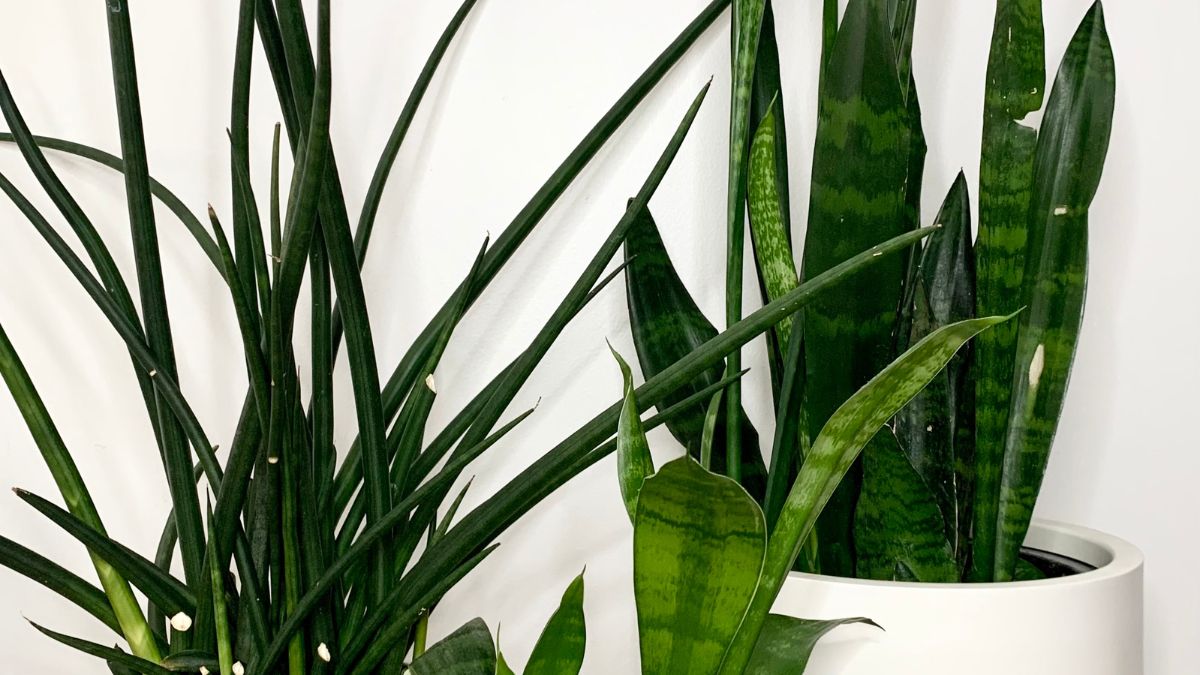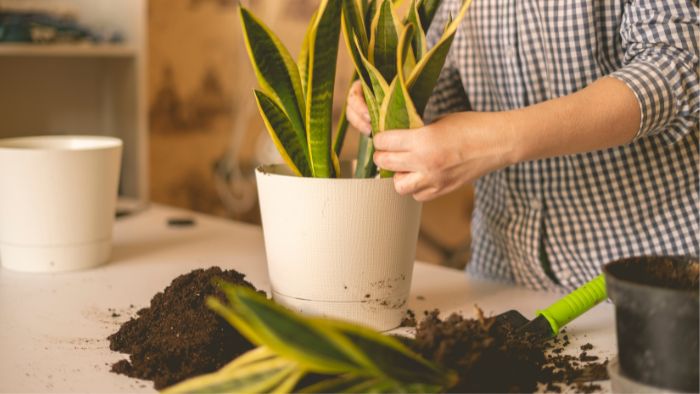Last Updated on March 20, 2023 by Cristina
When it comes to knowing how to fix a snake plant with damaged leaves, I have to confess I have never bothered doing this. These plants grow so well and so easily around my garden that this hardly ever happened to my plants! However, luckily, I was able to speak to my Mom who has decades of experience growing these plants when my brother and I were kids – and knows how to remedy the “biological” damage that kids cause to the leaves.
A Quick Overview Of The Snake Plant
The snake plant is a drought-adapted plant. They used to be in the genus Sansevieria but have been moved to the genus Dracaena. This causes some confusion as many people call these plants Sansevierias. The snake plant is a succulent plant that employs CAM photosynthesis – this means that it can conserve water, and uses a relatively inefficient photosynthetic system that gives it an advantage in a dry climate. Your snake plant needs a dry climate to be happy!
Typically these plants grow under other plants in the wild – in other words, they normally receive dappled sunlight and not long periods of direct sunlight. Most of the times I have seen them in the wild in the Congo, South Africa, Zambia, Madagascar, and Mauritius they tended to be growing in quite poor sandy soil. Even if they were in an area with high rainfall, they were actually in dry soil, because the soil drains very fast. In the Congo, it can rain three inches, and a day later the top five inches of the soil are already dry because it is hot, and sandy and the soil is impoverished.
Snake plants in the wild in the Eastern Cape, South Africa. These plants thrive growing under other plants where they receive dappled sunlight, and where water is not abundant.
When we talk about snake plants there are actually quite a few different species that are grown that all look a bit the same. If you understand the above basic biology of the plant, it is relatively easy to allow them to thrive and flourish! Don’t overwater, give them 12 or so hours of decent dappled light (ie not direct) and put them in a miserable sandy soil! Occasional fertilizer application probably mimics the lucky moments in the wild when a chimpanzee, elephant, or some other creature peed on them.
What Can Cause Broken Leaves In Snake Plants?
There are many factors that can cause damaged leaves in snake plants. The most common cause of broken leaves are kids, pets, drunk people, and objects falling on the plants. If your leaves are long and scraggly due to the plant growing in low light, you may also find that gusts of wind due to an open window can cause leaves to break. Under normal conditions, these plants survive strong wind! I have seen snake plants emerge unscathed from a cyclone (the equivalent of a hurricane) in Mauritius where the plants were exposed to a day of wind that was 90-100 mph.
How To Fix A Snake Plant With Damaged Leaves
As mentioned earlier, I have personally never worried about this as I cannot recall ever having the problem. However, my brother and I were terribly destructive kids and I vaguely remember a number of hidings being received due to destroying my mother’s beloved “Sansevierias”. My Mom also managed a large public building that had “Sansevierias” all over – and whenever there was a party drunk students would urinate and break the leaves. I phoned her to find out her tips on how to fix a snake plant with damaged leaves.
Learn more about: Growing Snake Plants In An Outdoor Container
Root The Leaves You Trim To Produce More Plants
Her advice on how to fix a snake plant with damaged leaves was relatively simple – cut the damaged leaves off. Place the leaves in water and let them root. Apparently, the plants grow so fast if they are given acceptable conditions that trimming of broken leaves neatens them up and encourages growth.
Her additional advice was to place the leaves that are cut off in jars or glasses filled with an inch or so of water and place these on a windowsill somewhere where they get mild but not strong sunlight. The leaves take a month or so to root, and once the leaves root, you can place these in small pots with well-drained sandy soil.
Avoid Cracking Your Ceramic Pots By Repotting Occasionally
By rooting up additional plants you can plant these into gaps in the bigger pots where the original plants came from. From time to time it is also advisable to remove the snake plants from the pot, remove the soil and replace it with fresh soil. These plants have quite strong and aggressive roots – if you have a nice large ceramic pot with snake plants growing in it, what can happen is after a few years the snake plant roots take up the majority of the space in the pot.
Typically, with snake plants, the best way to water them is to water occasionally and allow the soil to dry out. During this time the plants will use some of their stored water in their roots to grow, which helps the plant. However, when you water again, the roots can expand – and if there is no space left, the pot will crack! I have seen this happen.
Deterring “Child Or Pet Damage” To Snake Plants Using Cacti
As mentioned earlier, children/pets are a major cause of damage to snake plants. Planting a row of smaller, spiky cacti in directions from which children/pets may approach the snake plants can create a physical/psychological barrier.
Cacti rapidly educate all young creatures to avoid them. Youthful skin is very sensitive – cacti that are not particularly scary to adults leave lasting educational memories in a three-year-old mind. At this age, the learning process is very rapid, hence one or two brief entanglements with a cactus can help to deter the child from further exploration into the rest of the pot plant where the snake plants may be damaged. I find, 43 years after being a toddler I still find I have an instinctual fear to touch cacti. Even with gloves on. Those memories are lasting.
I hope this article has helped you understand how to fix a snake plant with damaged leaves. Part of knowing how to fix a snake plant with damaged leaves is to avoid it happening again as well! Cacti provide that little bit of assistance many of us with young kids/grandkids may need. If you found this article on how to fix a snake plant with damaged leaves helpful, please share.
Read more about: Are There Any Other Plants Similar To Snake Plant?
FAQs
Should I trim damaged snake plant leaves?
You can trim them, cut them into pieces and place them in a jar or cup of water with about an inch of water in it. Place them on a windowsill with indirect sunlight. They will root and can be planted into soil after they root.
Will cut snake plant leaves grow back?
No, but more leaves will grow to take their place. Snake plants, when happy and healthy, grow relatively fast and regenerate quite rapidly.
How do you fix a damaged snake plant?
Remove damaged leaves. Identify the cause of damage. If the cause of damage is a child or a pet, repot the plant in such a way that you can plant a few thorny cacti before the snake plant in the direction the child or pet would take to reach and damage the plant. Cacti are remarkably effective at educating children and pets as to why not to touch them.
How do you get rid of damaged snake leaves?
The easist is just to trim them off. If you want to you can use these trimmed leaves to grow new plants. The new plants can be used to fill in spaces in the snake plant pot.
Dr. Garth A. Cambray is a Canadian/South African entrepreneur and beekeeper with 28 years of experience in apiculture and specializes in adding value to honey. His Ph.D. research developed a new advanced continuous fermentation method for making mead that has resulted in a number of companies globally being able to access markets for mead. His company, Makana Meadery, exports honey mead to the USA where it is available to discerning connoisseurs. He has also developed technologies to commercially manufacture organic honey vinegar in Zambia for export globally. He holds a few patents globally in the ethanol industry and believes in technology and knowledge transfer for human development and environmental sustainability. One of his proudest achievements is the fact that the wind farm he started at one of his old apiary sites has essentially made his hometown carbon neutral.





